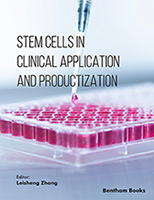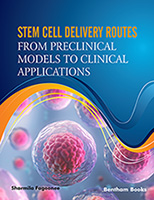Cellular-based therapies for regenerative medicine have evolved quite significantly in the past decades. The realization that such an endeavor requires the acquisition of an adequate stem or progenitor cell population, techniques to effectively maintain or induce the desired phenotype and efficient culturing and implantation conditions have led researchers to develop a wide variety of protocols to approach the issue. The goal of this eBook is to review the recent advances and applications of stem cells in regenerative medicine. The book content can be generally divided into 3 sections: Ethics, Basic Biology and Clinical Applications.
The ability of pluripotent stem cells to generate various replacement cells and tissues presents the potential of their application in cell-based regenerative therapies. Although human embryonic stem cells are, in principle, the most versatile source of pluripotent stem cells, ethical controversies, immunogenic rejection and spontaneous tumor formation remain major concerns for their use in transplantation.
Ritter et al. focused largely on issues relating to the moral status of the embryo and suggest an ethically-optimized framework be established to help guide research in particular, the issues of social justice and the importance of both protecting vulnerable populations from bearing too great a burden for research while receiving too little of its benefits.
In contrast to ES cells, adult stem cells transplanted in pre-clinical animal models have shown no evidence of tumor formation and can be obtained mostly at all developmental stages and from numerous anatomical sites. Due to their broader clinical use, extensive research, and a more comprehensive understanding of their physiology, bone marrow-derived cells appear as the first choice for applications in regenerative medicine. Numerous environmental and trophic factors have been identified to play central roles in regulating the self-renewal, proliferation, migration, differentiation, senescence, and death of stem cells, their derived progeny, and the final differentiated cells that perform all tissue and organ functions. Besides direct differentiation of the stem cells to the desired mature cell type, other indirect mechanisms have been identified to play important roles in the overall repair of the injured tissue. These include production of paracrine factors, modulation of the host inflammatory response, host cell survival, and recruitment and activation of host tissue stem cells. (Rios et al.)
To deliver cellular products capable of replacing damaged tissue and/or cells, one must understand that the need for the balance between cellular proliferation and differentiation is a carefully controlled process involving a range of growth factors and cytokines produced in large part by tissue stromal cells. These stromal cells make up the tissue microenvironment and appear to be essential for normal homeostasis. McNiece and Hare hypothesize that tissue damage involves damage to the microenvironment resulting in a lack of signals through growth factor networks necessary to maintain survival and proliferation of tissue specific stem cells and progenitor cells. Therefore, optimal repair of disease tissue must account for the damage to the stromal environment. Optimal cellular therapies for regenerative medicine will require combination cellular products consisting of a stromal cell population to reconstitute the microenvironment and to support the survival, proliferation and differentiation of the tissue specific stem cells or progenitor cells.
Huang et al. try to define the functional metrics required for engineering articular cartilage, and to situate the current state of MSC-based constructs within this framework. They examine the components and function of the native tissue, and review the progress made to date using differentiated cartilage cells (chondrocytes) for cartilage tissue engineering. This discussion includes methods of formation, biochemical formulations for enhancing in vitro development, as well as progress made towards using mechanical forces to further direct maturation. They then review the origins and applications of adult multi-potential stem cells, and discuss how routes towards cartilage tissue engineering with stem cells match (or fail to match) those approaches that were successful using differentiated cells. In particular, they describe new requirements to be understood for cartilage formation with MSCs, and outline several research areas that may inform this new direction in cartilage tissue engineering
The application of biomimetic mechanical forces for stem cell differentiation is a technique that has been on the rise in recent years. The effects of these forces on stem cells are the most commonly explored combinations in functional tissue engineering. Paleaz et al. summarized the current findings in functional tissue engineering, explain the importance of engineering in medical research, and describe the ways tissue engineers are attempting to understand what biochemical changes are occurring in the stem cells during the application of mechanical stress
The goal of angiogenic therapy is to activate endogenous angiogenic and arteriogenic pathways and stimulate revascularization of ischemic myocardial tissue. The feasibility of such a strategy has now been established through the results of studies over the past two decades, and clinical trials involving more than 1000 patients have been implemented. Critical evaluations reveal that neither proteins nor genes delivered by transient expression vectors provide an optimal therapy. Similarly, stem cell therapy is not achieving the level of improvement that was expected or predicted from preclinical results. The future of therapeutic angiogenesis lies in the use of permanent gene delivery vehicles expressing regulated genes and/or stem cells appropriately engineered with regulated genes (Keith A. Webster).
The use of progenitor/stem cells to modulate the sensory systems in chronic pain is a new field in translational research. Stem cells or progenitor approaches have been tested in cardiac myopathies, liver dysfunction, stroke, and genetic abnormalities, but almost none have applied progenitor cells to the relief of neuropathic, pain. Perhaps the best studied neural progenitor cell line NT2, has recently resulted in two NT2-derived cell lines: hNT2.17, secreting the inhibitory neurotransmitters GABA and glycine; and hNT2.19, secreting the neurotransmitter serotonin. Each of these NT2-lines has demonstrated antinociceptive potential in models of SCI-related neuropathic pain, in peripheral neuropathy, and diabetic neuropathic pain. These human progenitors may prove to be useful in the relief of chronic pain and open the way to other regenerative approaches to pain management (Eaton et al.)
Early results of therapy with neural stem cells have been attributed to factors released by infused cells and investigator bias. The stem cell progeny identified as neurons by antigen expression and by morphology has been questioned, leading to the re-interpretation of these results by investigators who first reported them. Despite the diminished expectations, regenerative cells, or structures that mimic the function regenerative cells possess, are present in germinal areas of the adult human brain, albeit in limited numbers. Evidence does suggest that damaged brain tissue does, in some patients, regenerate with recovery of lost function. These cellular entities have not been widely studied, characterized but they may be similar to structures generated in neural tissue of primitive vertebrates which have a remarkable capability to regenerate intact, functional brain. These structures can potentially be expanded using methods that differ vastly from stem cell culture methods employed to date. Successfully expanded and stored, these structures may provide an effective means to regenerate brain tissue after stroke and traumatic brain injury in humans (English et al.)
The existence of clinically successful islet transplantation for type I diabetes has stoked a keen interest in developing alternative, inexhaustible sources of insulin-producing cells. Domínguez-Bendala and Ricordi cover the state of the art regenerative therapies for the endocrine component of the pancreas, from stem cells to transdifferentiation. They review the basics of pancreatic development, whose recapitulation remains the subject of a plethora of in vitro differentiation strategies using both embryonic and adult stem cells. They also examine the leading theories about the cellular and molecular mechanisms behind the in vivo regeneration of the organ that is observed under specific circumstances, as well as the purported ability of some tissues to turn into pancreatic endocrine cells when subjected to specific interventions (transdifferentiation). They conclude with a general overview of the remaining challenges and clinical perspectives of all the above strategies, with a special emphasis on the immunological hurdles to be overcome for these approaches to find their way to standard clinical practice.
To date, several sources of dental stem cells have been isolated and being characterized as dental epithelial stem cells, dental pulp stem cells, dental follicle precursor cells, stem cells from human exfoliated deciduous teeth, stem cells from apical papilla, and periodontal ligament stem cells. Dental stem cells have been shown to have multi-potential by their ability to differentiate into neuronal, adipogenic, myogenic, chondrogenic, osteogenic and dentinogenic cells when cultured under specific conditions. These facilitated studies to address an important property of stem cells, that is, the capacity of a given stem cell population to regenerate an organized, functional tissue following transplantation in vivo. Furthermore, the ready availability of tooth tissues from redundant teeth such as third molars can provide a good supply of dental stem cells that may be utilized for regenerating other body parts or organs (Zheng and Cheung).
Yam et al. address the important questions regarding functions of cornea epithelial progenitor cells (CEPCs) and therapeutic strategies in health and diseases. The human cornea is a site of tissue-specific adult progenitor cells, residing between cornea and conjunctiva in the Palisade of Vogt of the limbus region. While specific molecular markers of CEPCs are still unknown, recent research provide new information to apply them for cell replacement in damaged tissues. Cultured CEPCs have been used for ex vivo cornea therapy with satisfactory clinical outcome. While the niche environment, i.e., the extracellular matrix, growth factors and cytokines, provide regulatory measures in the proliferation of CEPCs, the recent discovery of CEPC specific microRNAs opens a new direction of research on the biological properties of CEPC and stem cells of other resources.
Last but not the least, I like to thank Ms. Lauren L. Vernon, who spent countless hours in working with all the authors.
Herman S. Cheung, PhD
James L. Knight Professor of Biomedical Engineering
Senior Veteran Affairs Research Career Scientist
Professor of Medicine & Orthopedic Surgery
University of Miami
USA





